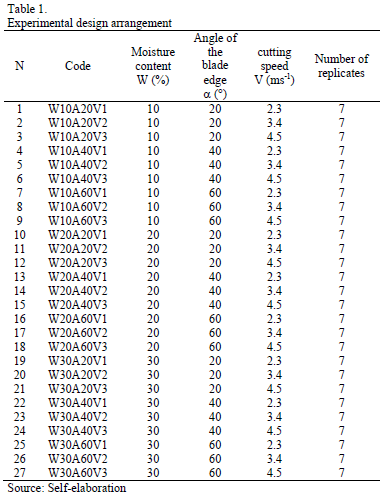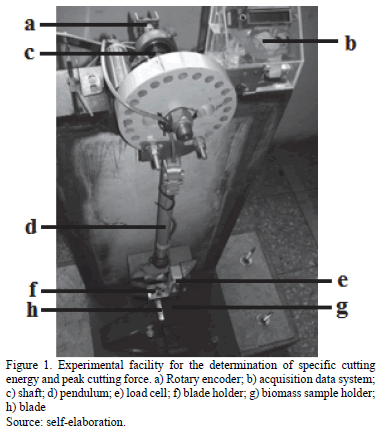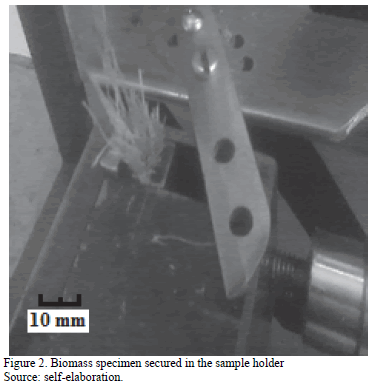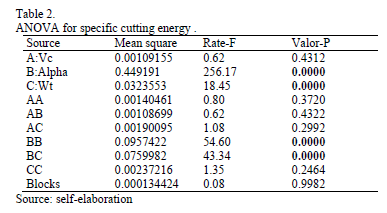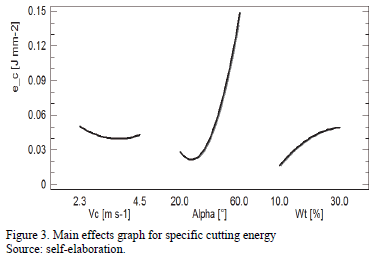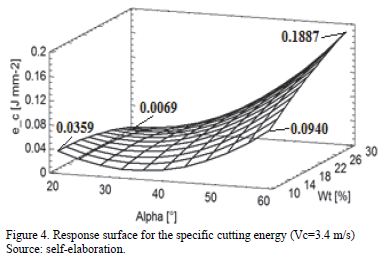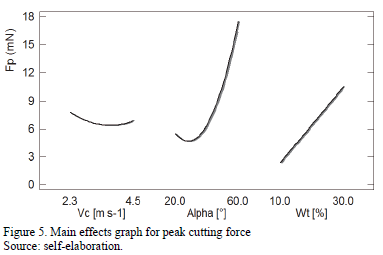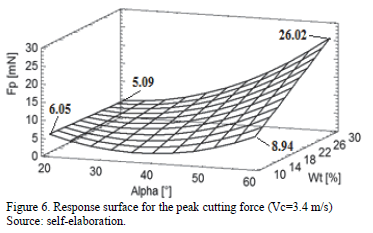Services on Demand
Journal
Article
Indicators
-
 Cited by SciELO
Cited by SciELO -
 Access statistics
Access statistics
Related links
-
 Cited by Google
Cited by Google -
 Similars in
SciELO
Similars in
SciELO -
 Similars in Google
Similars in Google
Share
DYNA
Print version ISSN 0012-7353
Dyna rev.fac.nac.minas vol.82 no.191 Medellín May/June 2015
https://doi.org/10.15446/dyna.v82n191.43816
DOI: http://dx.doi.org/10.15446/dyna.v82n191.43816
Study of the behavior of sugarcane bagasse submitted to cutting
Estudio del comportamiento del bagazo de caña de azúcar sometido a corte
Nelson Arzola a & Joyner García b
a Department of Mechanical and Mechatronics Engineering, Universidad Nacional de Colombia, Bogotá, Colombia. narzola@unal.edu.co
b Universidad Nacional de Colombia, Bogotá, Colombia. jdgarciava@unal.edu.co
Received: June 2th, 2014. Received in revised form: January 27th, 2015. Accepted: February 24th, 2015.
This work is licensed under a Creative Commons Attribution-NonCommercial-NoDerivatives 4.0 International License.

Abstract
The aim of this work was to study the behavior of sugarcane bagasse submitted to cutting, as a function of its moisture content, angle of the blade edge and cutting speed. The specific cutting energy and peak cutting force were measured using an experimental facility developed for this series of experiments. An analysis of the results of the full factorial experimental design using a statistical analysis of variance (ANOVA) was performed. The response surfaces and empirical models for the specific cutting energy and peak cutting force were obtained using statistical analysis system software. Low angle of the blade edge and low moisture content are, in this order, the most important experimental factors in determining a low specific cutting energy and a low peak cutting force respectively. The best cutting conditions are achieved for an angle of blade edge of 20.8° and a moisture content of 10% w. b. The results of this work could contribute to the optimal design of sugarcane bagasse pre-treatment systems.
Keywords: sugarcane bagasse; specific cutting energy; experimental model; biomass; pre-treatment.
Resumen
El objetivo de este trabajo fue estudiar el comportamiento del bagazo de caña de azúcar sometido a corte, como función de su contenido de humedad, ángulo de filo de la cuchilla y la velocidad de corte. La energía de corte específica y la fuerza de corte pico fueron medidas empleando un dispositivo experimental desarrollado para estos experimentos. Se realizó el análisis de los resultados del diseño factorial completo utilizando un análisis de varianza (ANOVA). Las superficies de respuestas y los modelos empíricos para la energía de corte específica y la fuerza de corte pico se obtuvieron mediante software estadístico. Un ángulo de filo pequeño junto con una baja humedad son, en ese orden, los factores experimentales más importantes para lograr bajos valores de energía de corte específica y de fuerza de corte pico respectivamente. Las mejores condiciones de corte se alcanzan para un ángulo de filo de la cuchilla de 20.8° y un contenido de humedad de 10% b. h. Los resultados de este trabajo pueden contribuir al diseño óptimo de sistemas para el pre-tratamiento de bagazo.
Palabras clave: bagazo de caña de azúcar; energía de corte especifica; modelo experimental, biomasa; pre-tratamiento.
1. Introduction
According to Larsson et al. [1], pelletized biomass is rapidly becoming an important renewable source of energy production. Several researchers have found that the mechanical integrity of the densified biomass was better in general for moisture contents of less than 15% (w.b.) and fiber sizes less than 19 mm [2]. Densification has encouraged significant interest around the world as a technique for utilization of agro and forest residues as an energy source [3], and pellets/briquettes production has grown rapidly in Europe, Northern America and China in the last few years. Mechanical densification of biomass into fuel pellets/briquettes has been shown to significantly reduce storage and transportation costs [4]. The cutting process is one of the most important steps for biomass preparation prior to densification. This stage helps to homogenize the raw material and therefore facilitate handling, feeding and filling in the briquetting equipment. Nowadays, for by-product industry, a better knowledge of material behaviour during cutting is needed for economical and productive reasons. Biomass machinery and tool manufacturers require reliable information on the main factors influencing biomass cutting, i.e. the specific cutting energy and peak cutting force [5-7].
The sugarcane industry generates large amounts of biomass, such as bagasse and straw, which can be used for power or thermal energy generation and for other engineering applications [8]. Processing the bagasse into a densified fuel through pelletisation will be an economically attractive option for this by-product. It is common practice to conduct a pre-treatment to biomass before pelletising, like cutting and drying. From an engineering viewpoint, few papers on biomass cutting process have been published, especially with respect to sugarcane biomass [9]. Also, the research that has been carried out in general on the pre-treatment of sugarcane bagasse and cutting machinery for bio-briquette production is very limited at this time [10-12]. Habib et al. [13] categorized the different parameters affecting the performance of the cutting process. They showed that the main parameter of the cutting tool is the knife-edge angle, and that of the biomass is the moisture content, whereas, for the operation machine conditions, the main parameter is the cutting speed.
The scope of this work was to assess the suitability of the cutting process for sugarcane bagasse. Extensive cutting tests were carried out in order to assess the physical variables involved. The variables explored included the moisture content, the angle of the blade edge and the cutting speed. Specific cutting energy and peak cutting force are both important parameters describing the cutting process, for that reason, the surface responses and empirical expressions for these parameters were obtained.
2. Material and method
2.1. Sugarcane bagasse biomass
The sugarcane bagasse was obtained from agricultural lands in the Cundinamarca Department, Colombia in January 2013 and stored for two weeks in the laboratory. The recollecting process was conducted carefully in order to avoid contamination of the samples with other process materials. This sugarcane bagasse came from 18-month-old plantations that use Colombian traditional cultivation processes.
2.2. Sample preparation
These samples were completely dehydrated in a muffle at a temperature of 80ºC for 10 hours. Once the samples were completely dried, they were weighted and hydrated in moisture percentages on a wet basis of 10%, 20% and 30%, accordingly, and left in a sealed recipient for three days. The determination of moisture content was carried out according to the EN 14774-3 Technical Standard [14]. Simultaneously, a mechanical mixing process was carried out at regular time intervals to guarantee the even distribution of the water. Each experimental treatment is labelled in the following way, W##A##V#, where: W [moisture content, %], A [angle of the blade edge, °] and V [cutting speed, ms-1].
2.3. Design of experiment
A systematic study was conducted where three factors were varied according to a three level full factorial design. The factors were: angle of the blade edge, cutting speed and bagasse moisture content. Finally, 27 experimental treatments were obtained. The experiments were replicated seven times for a total of 189 experimental units. Table 1 shows the experimental design arrangement. An analysis of the results of the full factorial experimental design using a statistical analysis of variance (ANOVA) was performed, an F test was conducted and the results evaluated at a 95% confidence level [15]. The response surfaces and empirical models for the specific cutting energy and peak cutting force were obtained using statistical analysis program developed in Matlab.
2.4. Cutting test
The energy and force required for cutting may vary depending on the raw material moisture content, the blade geometry and the speed of the cutting process. Laboratory experiments were conducted to evaluate the performance of a single edge knife, with different edge angles (20°, 40° and 60°) and cutting speeds (2.3 ms-1, 3.4 ms-1 and 4.5 ms-1) respectively, under controlled conditions. Most of the agricultural machinery employed for the cutting process use blades with edge angles in this range. On the other hand, the cutting speed range was limited for the operation of the experimental facility; nevertheless, the cutting speed range of the experiments matches the low range of speed found in several cutting agricultural machinery. The cuts were made by a lab scale-cutting unit able to control the process parameters shown in Fig. 1. The facility consists of a structure, a biomass sample holder and a pendulum with a blade holder. The bagasse samples are fixed in cantilever into the biomass sample holder and a mobile single blade executes the cut. An encoder, fixed in the pendulum rotation axis, allows the measurement of the initial and final angular positions; then a data acquisition system calculates the energy consumed during cutting.
The energy consumed in shearing a unit area of biomass is called the specific cutting energy. This response variable is calculated as the mechanical energy consumed during cutting divided by the transverse section of each biomass specimen. The mechanical energy was measured by means of the difference between angular positions of the pendulum; while the transverse section of the biomass specimen was measured by digital image processing (CAD software). Furthermore, the force involved in the cutting process is measured with a precision load cell located in the knife holder. The maximum force reached in the plane of cut is called the peak cutting force. Fig. 2 shows a biomass specimen secured in the sample holder. The biomass specimen is an array of circular shaped biomass bagasse fibers , which are joined at the base with adhesive tape. The cut is performed in the transverse direction to the fibers. The length of specimens was 100 mm and the diameter was 10 ± 2 mm.
3. Results and discussion
3.1. Specific cutting energy results
An analysis of the results of the full factorial experimental design using a statistical analysis of variance (ANOVA) was performed. Only the angle of the blade edge and the moisture content are statistically significant for the specific cutting energy achieved in the cutting process for 95% of probability. Table 2 shows the degree of significance of the coefficients for the factors and their interaction. The expression of the empiric model for the behaviour of the specific cutting energy in function of the angle of the blade edge and the moisture content of the sugarcane biomass obtained by applying the statistical software from experimental data is:

Where:
ec: Specific cutting energy (Jmm-2).
a: Angle of the blade edge (°).
Wt: Moisture content of the sugarcane bagasse (%).
Fig. 3 shows the main effects graph for specific cutting energy. The main effects graph is used to examine differences between level means for the three experimental factors. There is a main effect when different levels of an experimental factor affect the response differently. The main effects test is suitable for inspecting differences amongst the levels of a single experimental factor, averaging over the other factors. The steeper the slope of the curve, the greater the magnitude of the main effect. Fig. 4 shows the response surface for the specific cutting energy. It can be concluded that a low angle of the blade edge is the most important factor in determining a reduction in the specific cutting energy. Additionally, the cutting speed is not statistically significant for the specific cutting energy response.
3.2. Peak cutting force results
The analysis of the results of the full factorial experimental design was performed using a statistical analysis of variance (ANOVA). It was proved that the three experimental factors (considering the interactions between factors) are statistically significant for the peak cutting force achieved in the cutting process for 95% of probability. Table 3 shows the degree of significance of the coefficients for the factors and their interaction. The expression of the empiric model for the behaviour of the peak cutting force in function of the experimental factors is:
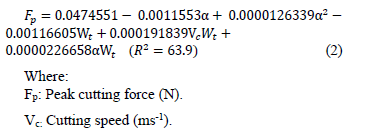
Fig. 5 shows the main effects graph for the peak cutting force. Fig. 6 shows the response surface for the peak cutting force. It can be concluded that both factors, low angle of the blade edge and low moisture content, are the most important factors in determining a decrease in the peak cutting force. Additionally, the cutting speed (single factor) is not statistically significant for the specific cutting energy response.
Despite there being no other found works on cutting sugarcane bagasse, several similitudes are found in this research with respect to other studies. For example, according with [9] the effect of cutting speed, there is little or nothing in the specific cutting energy required for cutting sugarcane trash by shearing, this behavior is similar in the current study. In another work [16], the researchers explain that the wheat straw is brittle and less viscoelastic to low moisture content and thus easier to cut; also they explained that the ideal moisture content to cut wheat straw was in the range of 8 to 10%. Similarly for the current study, it is possible to find that specific cutting energy for sugarcane bagasse is approximately doubled when the moisture content increases from 10% to 30%.
4. Conclusions
In this study, results show a good statistical correlation between specific cutting energy, the angle of the blade edge and the moisture content respectively (R2=68.6). Also, results show a good statistical correlation between peak cutting force and the three experimental factors studied (R2=63.9). The analytical models of the sugarcane bagasse behavior and the energy and force involved during cutting were studied in order to choose the best cutting conditions. Low angle of the blade edge and low moisture content are, in this order, the most important experimental factors in determining a low specific cutting energy and a low peak cutting force. According to the analysis of the response surface for specific cutting energy, the best cutting conditions are achieved for an angle of blade edge of 20.8°, a cutting speed of 2.89 ms-1 and a moisture content of 10% (w.b.) respectively; the minimum specific cutting energy was obtained for this set of reference values ( ). The results of this work could contribute to the optimal design of bagasse pre-treatment systems.
). The results of this work could contribute to the optimal design of bagasse pre-treatment systems.
References
[1] Larsson, S.H., Thyrel, M., Geladi, P. and Lestander, T.A., High quality biofuel pellet production from pre-compacted low density raw materials. Bioresour. Technol, 99, pp. 7176-7182, 2008. DOI: 10.1016/j.biortech.2007.12.065 [ Links ]
[2] Bissen, D., Biomass densification, document of evaluation. Agricultural Utilization Research Institute, Minneapolis: Zachry Energy Corporation, 2009. [ Links ]
[3] Bhattacharya, S.C., Biomass energy use and densification in developing countries. Paper presented at the Pellets 2002: The First World Conference on Pellets, Stockholm, Sweden, 2002. [ Links ]
[4] Mani, S., Sokhansanj, S., Bi, X. and Turhollow, A., Economics of producing fuel pellets from biomass. Appl Eng Agric, 22 (3) pp. 421-426, 2006. DOI: 10.13031/2013.20447 [ Links ]
[5] Méausoone, P.J., Choice of optimal cutting conditions in wood machining using the coupled tool-material method, in: Proceedings of the 15th International Wood Machining Seminar, pp. 37-47, 2001. [ Links ]
[6] Davim, J.P., A note on the determination of optimal cutting conditions for surface finish obtained in turning using design of experiments. J. Mater. Process. Technol, 116 (2), pp. 305-308, 2001. DOI: 10.1016/S0924-0136(01)01063-9 [ Links ]
[7] Eyma, F., Méausoone, P. and Martin, P., Strains and cutting forces involved in the solid wood rotating cutting process. Journal of Materials Processing Technology, 148, pp. 220-225, 2004. DOI: 10.1016/S0924-0136(03)00880-X [ Links ]
[8] Osorio, J.A., Varón, F. and Herrera, J.A., Mechanical behavior of the concrete reinforced with sugar cane bagasse fibers. DYNA, 74 (153), pp. 69-79, 2007. [ Links ]
[9] Bianchini, A. and Magalhaes, P., Behavior of sugarcane trash submitted to shearing in laboratory conditions. Rev. bras. eng. agríc. ambient. Campina Grande, 8 (2/3), pp. 304-310, 2004. [ Links ]
[10] Bianchini, A. and Magalhaes, P.S.G., Evaluation of coulters for cutting sugar cane residue in a soil bin. Biosystems Engineering, 100, pp. 370-375, 2008. DOI: 10.1016/j.biosystemseng.2008.04.012 [ Links ]
[11] Bianchini, A., Desenvolvimento teórico experimental de disco de corte dentado passivo para corte de palhiço em cana-de-açúcar. Tesis Dr., Faculdade de Engenharia Agrícola, Universidade Estadual de Campinas, Brasil, 2002. [ Links ]
[12] Marey, S.A., Drees, A.M., Sayed-Ahmed, I.F. and El-Keway, A.A., Development a feeding mechanism of chopper for chopping sugarcane bagasse. Misr J. Ag. Eng., 24 (2), pp. 299-317, 2007. [ Links ]
[13] Habib, R.A., Azzam, B.S., Nasr, G.M. and Khattab, A.A., The parameter affecting the cutting process performance of agricultural plants. Misr J. Ag. Eng., 19 (2), pp. 361-372, 2002. [ Links ]
[14] European Standard EN 14774-3:2009, Solid biofuel. Determination of moisture content, oven dry method. Part 3: moisture in general analysis sample, 2009. [ Links ]
[15] Kuehl, R.O., Design of experiments: Statistical principles of research design and analysis. Second Edition, Duxbury/Thomson Learning, 2000. [ Links ]
[16] Kushwaha, R.L., Vaishnav, A.S. and Zoerb, G.C., Shear strength of wheat straw. Canadian Agricultural Engineering, Winnipeg, 25 (2), pp.163-166, 1983. [ Links ]
N. Arzola-de la Peña, received the BSc. Eng. in Mechanical Engineering in 1997 and the MSc. degree in Applied Mathematic in 1999, both of them from the Universidad de Cienfuegos, Cuba; after that received the PhD. degree in Technical Science in 2003 from the Universidad Central de las Villas, Cuba. From 1997 to 2004, he was an Assistance professor in the Mechanical Engineering Department, Universidad de Cienfuegos, Cuba; and since 2005 he is an associate professor in the Department of Mechanical and Mechatronics Engineering, Universidad Nacional de Colombia, Bogotá, Colombia. His research interests include: modeling, design and optimization of machines; robust design; and failure analysis and structural integrity of machines.
J.D. García-Vásquez, received the BSc. Eng. in Mechanical Engineering 2008, the MSc. degree in Mechanical Engineering in 2015 all of them from the Universidad Nacional de Colombia. From 2008 to 2012, he worked for the Dairy Industry in the Maintenance Department. In 2012 and 2013 he was a full professor in the Metalworking Center, Capital District, SENA. Currently, he is a Project Engineer in the Engineering and Integral Services of Colombia.













